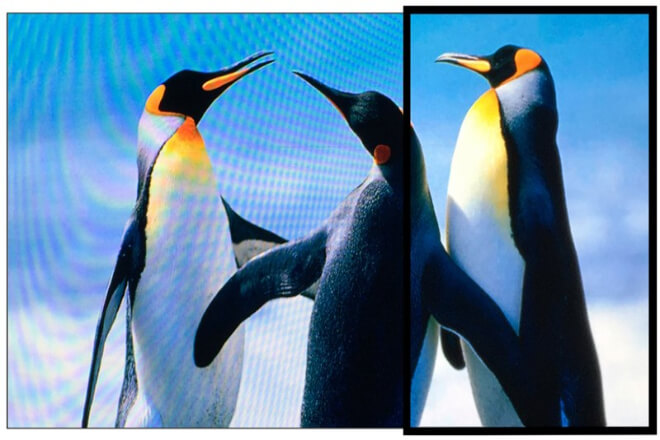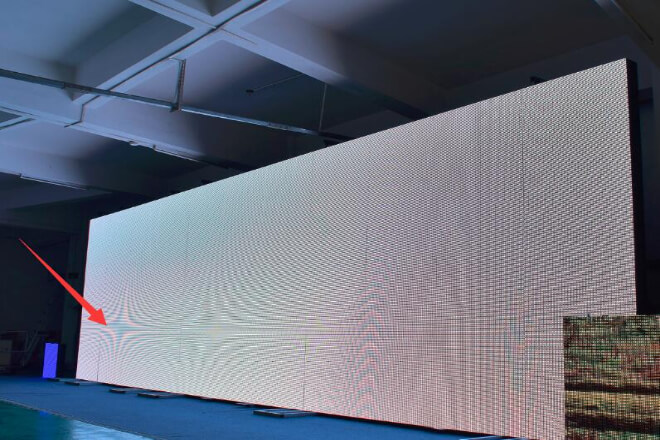Introduction

Under the gorgeous lights of the XR stage, the LED display is like a dreamlike canvas, presenting a visual feast for the audience. However, when moiré appears quietly, this beautiful picture is destroyed. So, how can we quickly solve the moiré problem during shooting?
Table of Contents
1. Analysis of the causes of moiré

The appearance of moiré, after all, is inseparable from the interference and diffraction of light. It is like two sets of waves with similar frequencies.
When they meet, the synthesized wave will change according to the frequency difference, which easily forms an interference pattern.
In space, if two sets of gratings with similar stripe intervals meet, because the overlapping position will slowly shift, a beat will be generated, and moiré will appear.
Looking at the diffraction of light again, when light passes through the light-transmitting slit of the grating, diffraction will occur.
If there are two sets of gratings, the situation will be more complicated. The diffracted light in different directions interferes with each other and finally forms moiré fringes.
Equipment parameters also have a critical impact on moiré. First, let’s look at the LED display. The smaller the dot pitch, the higher the spatial frequency.
If the dot pitch does not match the spatial frequency of the pixel structure of the shooting device, moiré is likely to appear.
LED displays with high resolution have higher spatial frequencies, and the interaction with the shooting device is more complex, so moiré is more likely to appear.
Looking at the shooting device again, the pixel density and spatial frequency are high. When the pixel density is close to the spatial frequency of the LED display, moiré is likely to occur.
The focal length of the lens is also very important. Different focal lengths will result in different image sizes and clarity, which will affect the matching relationship between the spatial frequencies of the two and thus affect the generation of moiré.
Environmental factors also have an impact on the generation of moiré. The intensity of stage lighting is an example.
If the light is too strong or too weak, it will change the brightness and contrast of the LED display, affecting the shape and intensity of the moiré.
The lighting angle is also critical. Lights at different angles will cause different reflections and refractions of the LED display, affecting the appearance of moiré.
In addition, the contrast between the stage background and the LED display is also very important. With a large contrast, moiré is easier to see.
If the colour and brightness of the stage background and the LED display screen are in sharp contrast, the moiré pattern will be more obvious.
2. What effects will the moiré pattern have on the xr stage LED display screen?

1). Affecting the visual effect
The moiré pattern is like adding a layer of “gauze” to the picture, making a good picture messy.
Once the moiré pattern appears, the details of the originally clear picture are not clear, just like being covered by a layer of gauze.
In addition, the contrast between light and dark in the picture becomes very strange, and the contrast that should have been very sharp becomes blurred, and the whole picture looks grey and not attractive at all.
Also, the colour will become very strange, and sometimes rainbow-like colour stripes will appear, which are completely different from the actual picture, making people look very awkward.
2). Interfering with the shooting effect
When shooting the XR stage, moiré is simply a “troublemaker”. The pictures taken by the camera are all messy stripes and cannot be used at all.
The post-production staff have to spend a lot of time to repair these pictures, and the workload has increased a lot at once, and the cost has also increased.
Moreover, sometimes the effect is not ideal after the repair, and the picture still has some problems.
3). Affecting the audience experience
For the audience, moiré is like a “distraction” swaying in front of their eyes.
The audience’s attention will be attracted by these messy stripes, and they can’t watch the stage performance properly.
In addition, if the moiré is particularly obvious, the audience may feel uncomfortable in the eyes or even dizzy and may not be able to watch it in the end.
4). Affecting the presentation of stage effects
In the XR stage, LED display screens are used to create virtual scenes, but once moiré appears, the coherence and realism of the entire scene are destroyed.
It is difficult for the audience to fully immerse themselves in the virtual stage environment, and it feels like watching a flawed stage.
For actors, moiré will also affect their performance. Actors may be distracted by these interference patterns, and the performance effect will deteriorate, and the effect of the entire stage performance will be greatly reduced.
3. Analysis of existing technical means to avoid moiré on LED display screens

1). Hardware optimization
Nowadays, some LED display screens have a very high refresh rate, just like the screen is refreshing quickly, which can make the screen look smoother, with less flickering and less chance of moiré. Speaking of refresh rate, we have to mention the IC card.
The LED display screen is like a “commander” that can quickly control the on and off of small lamp beads (LED) on the screen.
In the past, the display screen was prone to “stuck” when the screen moved, which was very uncomfortable to watch.
Now, with an IC card, it can update the screen super fast, just like installing an “accelerator” for the screen, and the refresh rate is rising.
There is also a very powerful technology, which is to add a special optical coating on the surface of the LED display screen.
This coating is a bit like putting a “magic coat” on the screen, which can change the screen from point light to surface light.
In short, it is to turn small bright spots into soft light so that the moiré can be “driven away,” and the picture can be made clearer, the color is brighter, and it looks good from all angles.
2). Software algorithm
A software algorithm is like “beautifying” the picture. For example, using some professional software, such as Nikon Capture or Photoshop plug-ins, you can remove the moiré in the picture after shooting.
However, this method is a bit like an “after-the-fact remedy”. It would be better if it could be processed in real-time.
Now, some new technologies are studying how to correct the picture in real-time during shooting to reduce moiré.
Although it is still being perfected, it sounds very powerful and may be used more in the future.
3). Adjustment of shooting equipment
Adjusting the parameters of the shooting equipment can also reduce moiré. For example, if you lower the ISO, the noise in the picture will be less, and moiré will not appear so easily.
The shutter speed is also critical. If the shutter speed and the refresh rate of the screen can match, the moiré will be much less.
There is also a low-pass filter, which can filter out the high-frequency parts of the picture, making the chance of moiré less, but the disadvantage is that the picture will become less sharp.
4. What can I do if the xr stage LED display encounters moiré during shooting?

1). Adjust the shooting equipment
If you encounter moiré during shooting, you can try to move the camera first. For example, rotate the camera slightly or move the camera up, down, left, and right, and you may find a place where the moiré is not so obvious.
If you can adjust the focal length of the lens, you can also try to zoom or fine-tune the focus to change the clarity of the picture a little, and the moiré may not be so obvious.
If you have a low-pass filter, you can also try to install it on the lens. Although the image may become less sharp, it can reduce moiré, which is a stopgap measure.
2). Adjust shooting parameters
If the equipment at hand allows, you can also adjust the shooting parameters.
For example, lower the ISO value so that there will be less noise in the picture and the probability of moiré will be smaller.
For another example, adjust the aperture and use a smaller aperture, such as f/8 or f/11, so that the depth of field will increase and the moiré may be reduced.
However, these adjustments should be made carefully so as not to affect the overall effect of the picture.
3). Adjust the LED display
If conditions permit, you can also try to adjust the LED display itself.
For example, adjust the resolution of the display appropriately to reduce the possibility of uneven patterns, but be careful not to affect the overall quality of the image.
If there is a diffuser on site, it can also be used in front of the LED display. It can make the light more evenly distributed, mix the pixel pattern, and make the moiré less obvious.
4). Real-time software processing
If you have tried all the above methods and moiré still exists, you can try to use professional software tools to process the image in real-time.
These software usually have the function of removing moiré and use algorithms and tools to eliminate or reduce the impact of moiré.
Although this may require some technical knowledge, using software processing on the set may be effective immediately.
5. Conclusion
Through the above methods, we can effectively solve the moiré problem during the shooting process to ensure that the visual effect of the XR stage is not affected, whether by adjusting the shooting equipment or optimizing the shooting parameters.
Using software processing can help us deal with sudden moiré problems. Of course, the best way is to be fully prepared before shooting and try to avoid the appearance of moiré.
Finally, if you want to know more about LED displays, please get in touch with us.
